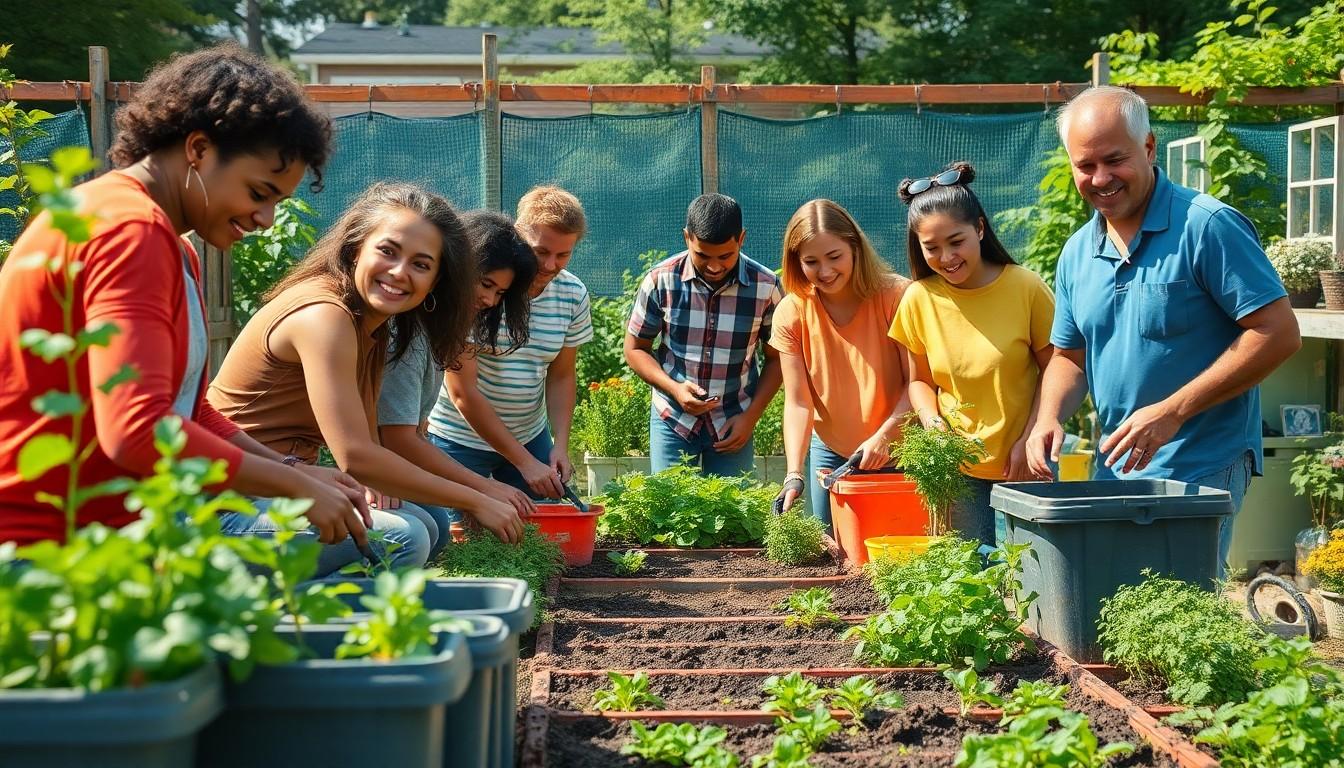In a world where plastic seems to breed like rabbits and climate change feels like that annoying relative you can’t escape, sustainable living practices are the superheroes we never knew we needed. Imagine a life where your morning coffee doesn’t come with a side of guilt and your home is as eco-friendly as a tree-hugging panda. Sounds dreamy, right?
sustainable living practices
Sustainable living practices encompass a variety of actions that promote ecological balance and resource conservation. Individuals adopting these practices contribute significantly to reducing waste and lowering carbon footprints. Many choose to prioritize renewable energy sources, such as solar and wind, to power homes and businesses.
A key element of sustainable living involves minimizing single-use plastics. Opting for reusable bags, containers, and utensils helps mitigate plastic pollution. Sustainable diets rich in plant-based foods further enhance personal health while supporting environmental goals.
Water conservation techniques play an essential role in sustainable practices. Implementing rainwater harvesting systems or using drought-resistant plants in landscaping conserves precious water resources. Furthermore, individuals can make a difference by recycling and composting, which diverts waste from landfills and enriches soil quality.
Transportation methods influence sustainability efforts as well. Using bicycles, public transit, or electric vehicles reduces reliance on fossil fuels, thus diminishing air pollution. Additionally, supporting local businesses fosters a community-based economy that reduces transportation emissions.
Lastly, engaging in mindful consumerism promotes ethical purchasing decisions. Individuals can choose products from companies committed to sustainable practices, such as fair trade and eco-friendly materials. Together, these actions create a cohesive framework for living sustainably.
Benefits Of Sustainable Living Practices

Sustainable living practices offer various benefits that extend beyond individual actions. These advantages touch on environmental health, economic savings, and personal wellness.
Environmental Impact
Sustainable living significantly reduces ecological footprints. Individuals practicing sustainability can lower carbon emissions through renewable energy sources. Opting for reusable items decreases plastic pollution. Water conservation efforts, such as rainwater harvesting, enhance resource efficiency. Utilizing public transit or bicycles further reduces air pollution. Plant-based diets contribute to decreased greenhouse gas emissions while promoting biodiversity. These actions collectively foster a healthier planet.
Economic Advantages
Incorporating sustainable practices often leads to cost savings. Individuals can save money by reducing energy consumption through energy-efficient appliances and sustainable infrastructure. Minimizing single-use plastics and investing in reusable products decreases household waste expenses. Organic gardening offers both food security and savings on grocery bills. Additionally, ethical brands frequently invest in sustainable supply chains, promoting long-term economic stability. Choosing local products supports communities while reducing transportation costs.
Health Benefits
Sustainable living practices greatly enhance overall health. Prioritizing plant-based diets leads to improved nutrition and lower risks of chronic diseases. Regular physical activity, such as biking and walking, combats obesity and related health issues. Sustainable practices, like using non-toxic materials, reduce exposure to harmful chemicals. Access to fresh, local produce boosts mental well-being and encourages healthier eating habits. Individuals embracing these practices often experience reduced stress levels and a stronger connection to their communities.
Key Sustainable Living Practices
Embracing sustainable living practices impacts both the environment and personal well-being. Individuals can adopt several effective strategies in their daily lives.
Reducing Waste
Minimizing waste forms a cornerstone of sustainable living. Individuals can choose reusable items like water bottles and shopping bags to reduce single-use plastics. Composting food scraps enriches soil while keeping organic matter out of landfills. Purchasing products with minimal packaging further reduces waste creation. Educating communities about recycling practices enhances collective efforts in waste management. Engaging in upcycling transforms unused items into something valuable, extending their life. Communities can initiate programs to collect and repurpose electronic waste. These actions create a cleaner environment and foster a culture of sustainability.
Energy Conservation
Energy conservation stands as a critical focus in sustainable living. Utilizing energy-efficient appliances significantly reduces electricity consumption. Transitioning to LED lighting can cut energy usage by up to 80 percent compared to traditional bulbs. Implementing smart home technology allows for monitoring and optimizing energy use. Individuals should consider installing solar panels to harness renewable energy sources. Setting thermostats to energy-saving temperatures further conserves heating and cooling energy. Regular maintenance of heating and cooling systems maximizes efficiency. By engaging in these strategies, individuals contribute to a more sustainable energy future.
Sustainable Transportation
Sustainable transportation options aid in reducing environmental impact. Choosing bicycles for short trips replaces gas-powered vehicles, cutting emissions and promoting physical health. Public transportation provides an accessible alternative, lowering individual carbon footprints. Electric vehicles present another eco-friendly option, offering long-term sustainability. Carpooling reduces traffic congestion while fostering community connections among commuters. Implementing walking as a viable transportation choice benefits both personal health and the environment. Advocating for local infrastructure improvements enhances accessibility for all sustainable transport modes. Collectively, these transportation strategies significantly contribute to cleaner air and a healthier planet.
Implementing Sustainable Living Practices
Sustainable living practices can be integrated into everyday life through conscious choices and community engagement.
Creating a Sustainable Home
Creating a sustainable home involves implementing energy-efficient solutions and using eco-friendly materials. Prioritizing insulation helps reduce energy consumption, while energy-efficient appliances lowers electricity use. Choosing natural, non-toxic materials for furnishings and decorations promotes a healthier indoor environment. Utilizing LED lighting not only saves energy but also reduces overall electricity bills. Furthermore, rainwater harvesting systems and drought-resistant plants contribute to water conservation efforts.
Community Involvement
Community involvement plays a crucial role in promoting sustainable practices. Participating in local clean-up initiatives encourages collective efforts in reducing waste. Joining community gardens not only fosters local food production but also strengthens neighborhood ties. Supporting local businesses that prioritize sustainable practices helps create a more resilient local economy. Educational workshops can raise awareness about environmental issues and inspire others to adopt sustainable living. Collaboratively, these actions cultivate a supportive network focused on sustainability and environmental stewardship.
journey toward sustainability
Embracing sustainable living practices transforms not just individual lifestyles but also the health of the planet. By making mindful choices and engaging with the community, people can significantly reduce their ecological footprints and promote a more sustainable future.
Every small action counts from opting for renewable energy sources to choosing plant-based diets. These practices not only benefit the environment but also enhance personal wellness and community resilience.
As awareness grows and collective efforts strengthen, the vision of a cleaner healthier world becomes increasingly achievable. It’s time to take action and inspire others to join the journey toward sustainability.

